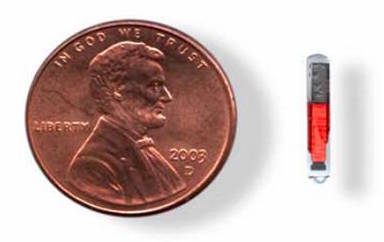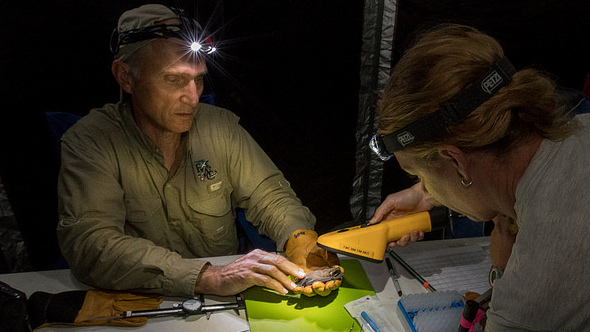
PIT tag shown next to an American penny. Wikimedia Commons
Passive integrated transponder (PIT) tags are the fingerprints of the tracking world. These tiny glass pills (about the size of a grain of rice) encase an integrated circuit chip, capacitor, and antenna coil that when activated, enable individual identification. Pioneered in the 1980s to study fish movements, they are used today to study the movements of amphibians, birds, invertebrates, fish, reptiles and mammals (including domestic pets!).
PIT tags are coded, like a barcode, to provide a unique alpha-numeric code unique to the individual. They are dormant (or passive) until activated by an external scanner and therefore do not require a power source. They typically last as long as the lifespan of the organism. When an animal carrying a PIT tag is recaptured (or passes by an automated reading system antenna), a scanning device generates an electromagnetic field to activate the tag. The tag then sends the alpha-numeric code back to the tag reader. Tags are generally inserted permanently into the animal either via a subcutaneous or intramuscular needle injection, or surgically implanted subcutaneously or into a body cavity.
PIT tagging is simple technology, but can be used to answer complicated questions about movement, survivorship, growth rates, and even food webs.

Helen Neville (left) and Doug Peterson (right) installing pass-through PIT tag detection antenna at a remediated culvert on a tributary to East Fork Lolo Creek, MT. USFWS.

FWC biologists use a PIT tag reader to identify a previously captured and tagged Florida bonneted bat. Merlin Tuttle/CC. Florida Fish and Wildlife Conservation Commission.
References
- Gibbons, W.J. and K.M. Andrews. 2004. PIT Tagging: Simple Technology at its Best. Bioscience: 54(5) 447-454. http://bioscience.oxfordjournals.org/content/54/5/447.full

